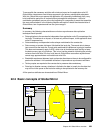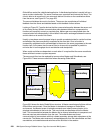
Chapter 22. Global Mirror overview 253
To accomplish the necessary activities with minimum impact on the application write I/O,
Global Mirror introduces a smart bitmap approach in the primary storage disk subsystem.
With this, Global Mirror can resume the application I/O processing immediately after a very
brief serialization period for all involved primary storage disk subsystems —this brief
serialization periodically occurs at the very beginning of a sequence of events that resemble
the ones outlined above. In the following chapters we explain in detail the characteristics of
Global Mirror, how it operates and how can you manage it.
Summary
In summary, the following characteristics are what an asynchronous data replication
technique should provide:
Data replication to the remote site independent from application write I/O processing at the
local site. This derives in no impact, or at least only minimal impact, to the application local
write I/O response time.
Data consistency and dependent writes always maintained at the remote site.
Data currency at remote site lags a little behind the local site. The remote site is always
less current than the local site. In peak write workloads this difference is going to increase.
This does not necessarily apply to XRC, which tries to throttle host write activity to keep
the data currency gap to a minimum. This in turn has the potential of blocking the primary
volumes from host write I/Os for a brief interval. Global Mirror as another asynchronous
remote copy approach does not throttle host write I/Os.
Bandwidth requirement between local and remote sites does not have to be configured for
peak write workload—link bandwidth utilization is improved over synchronous solutions.
Tertiary copies are required at the remote site to preserve data consistency.
Data loss in disaster recovery situations is limited to the data in transit plus the data that
may still be in the queue at the local site waiting to be replicated to the recovery site.
All the previous attributes are characteristics of Global Mirror.
22.2 Basic concepts of Global Mirror
Figure 22-7 Distributed application
Remote site
Local site
Server
Task1
Client
Client
Client
Network
Task1
Task2
Task2
Task3
Task3


















